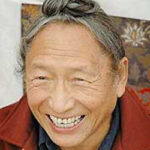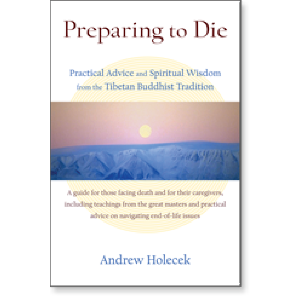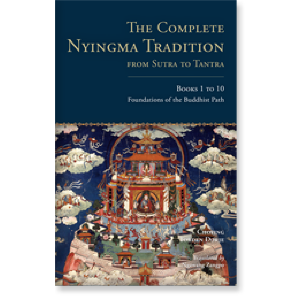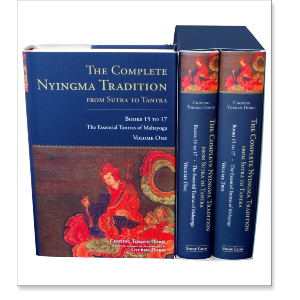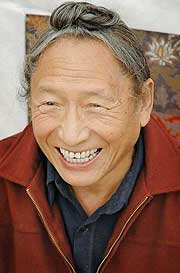
Lama Tharchin was born in Tibet and was a dzogchen master who received his training at Dudjom Rinpoche's monastery. He fled Tibet in 1959 to live in India and Nepal, before arriving in the United States in 1984. He was the tenth lineage holder of the Repkong Ngakpas, a family lineage of yogis. Rinpoche founded the Vajrayana Foundation and established a monastic college and three-year retreat center. He taught throughout the United States, and his gentle presence endeared him to thousands. Hhe was the driving force for the publication of The Complete Nyingma Tradition, a masterwork from the 19th century.
The following interview was conducted in Boulder, Colorado, and is excerpted from Preparing to Die: Practical Advice and Spiritual Wisdom from the Tibetan Buddhist Tradition by Andrew Holecek.
--------------------------------------------------------
What is the best thing for a practitioner to do before death?
We are now in the bardo of this life, which is from the moment of birth until the moment of a sickness that leads to our death. This is the time that is the best time to prepare. Dharma is how we can come to die professionally. That includes prostrations, circumambulation [around sacred sites and the gathering of merit], mandala offerings, Vajrasattva, taking refuge and generating bodhichitta, ngöndro, and then guru yoga. It is especially helpful to prepare with phowa practice. This is really powerful. We can practice phowa now, then when the time comes to actually do it, our chances for success are much greater. Reading Karma Lingpa's six bardo teachings is also helpful, along with the creation stage practices (of mahayoga). These deity and visualization practices are really wonderful. Then there are the completion stage practices and the Six Yogas of Naropa. This is all really important to do.
The main point is the recognition of your own enlightened buddha nature. When that wakes up in the bardo there is a chance you can be liberated at the level of the dharmakaya. The deity practices prepare you for the sambhogakaya. Any kind of practice is multiplied in the bardo, because consciousness is nine times smarter in the bardo. Therefore if we can practice in the bardo it's easier to attain liberation at that time.
What's the best thing one can do during death?
It is good if someone can read or remind the dying person to practice the teachings on the six bardos. In addition, try to remember these six things: remember the view, remember the deity, remember mantra, remember your samaya, remember your faith and devotion, remember love and compassion. It is also helpful to remember the Nyingma forms of liberation: liberation through taste (and the blessing substances, the relics), liberation through touching, through hearing, through seeing, through remembering, and through wearing. One can also read the Aspiration Prayer of Samantabhadra, or the Coppered-colored Mountain prayers-that can all be really helpful.
It is also very helpful to give teachings that will help the dying person recognize the bardo of dharmata, and to help them remember phowa. Practitioner or not, remind them to focus at the top of their head. You can also touch up there, or pull a little hair. Remember not to touch any lower parts of their body. Feeling directs consciousness, and it can make the consciousness exit from a lower door and take rebirth in a lower realm. You want consciousness to exit from the crown and merge with luminous emptiness awareness, so that your consciousness becomes vast like the sky. Reminding them of this is very helpful. There's also the recitation of all the Buddha's names, and the Chöying Dzö [Treasury of Dharmadhatu], by Longchenpa (which is what I usually recite). The root text is good to read.
What's the best thing to do after someone dies?
Each week, on the day that they died, they repeat the death experience, so this is a very special time for them and a time we can really help. You can do tsog (feast) offering on those days. Butter lamp offering is also special for those times, because the lamps represent clear mind-and help them find their way. If a practitioner is available, until the forty-ninth day, every day they could do the né dren ceremony, which is when you bring their consciousness into the support and then give empowerments and teachings and introduce the path that leads them to the pure land. You can also offer food and drink, and perform the sur offering. If you can do this every day until the forty-ninth day that is best (because seven weeks is the longest they can stay in the bardo), but especially in the first week, and then again for the third week. There is a phowa component in the né dren as well, so phowa is being practiced for them with this practice.
You can read also The Tibetan Book of the Dead, because bardo beings come back to hover around their loved ones during the bardo of becoming. This is the time when your prayers can penetrate and reach them directly, helping them. They can truly receive this help.
(from Preparing to Die by Andrew Holecek)

